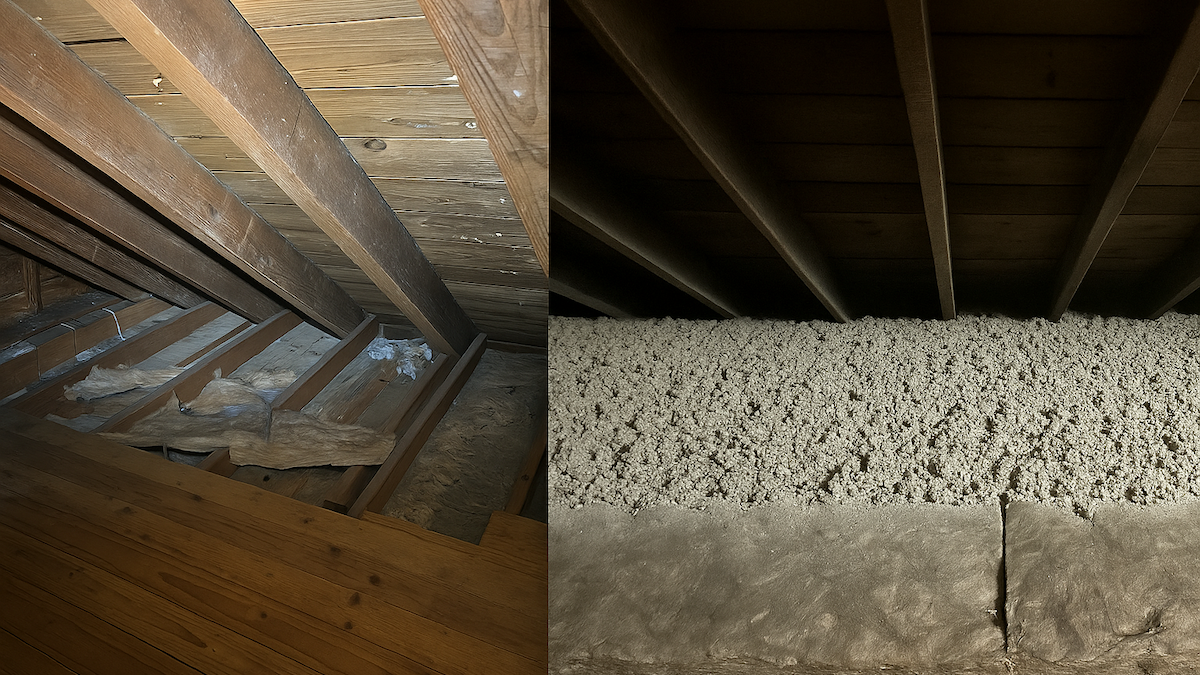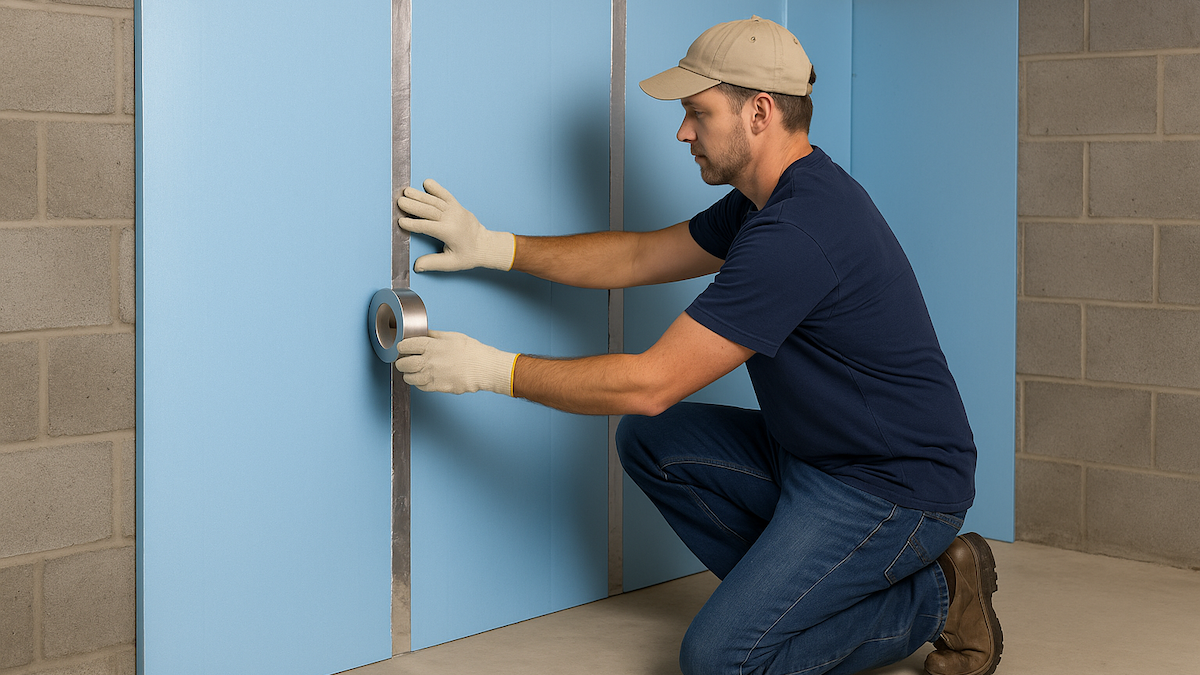Does Insulation Keep a House Cool? (Yes—and Here's How It Actually Works)
.jpeg)
It’s Not Just a Winter Problem
You’re sweating through your shirt. The AC’s blasting like it’s trying to cool the entire state of Connecticut, and yet your upstairs bedroom still feels like a sauna with drywall. You start wondering: Does insulation actually help keep a house cool—or is this just the price of summer?
Short answer? Yes, it absolutely helps.
But most folks only think about insulation once their toes are freezing—not when they’re sticking to the couch. The truth is, insulation isn’t just about staying warm in winter—it’s about staying comfortable year-round. In fact, if your attic or walls are poorly insulated, all that hot air is sneaking in like it owns the place. That means longer AC run times, higher energy bills, and a home that’s hot in all the wrong places.
In this post, we’re breaking down:
- How insulation works in the summer
- Where it matters most
- What kind of insulation helps beat the heat
- And how to tell if your home’s insulation is falling short
Let’s keep our cool—and save some money while we’re at it.
How Insulation Actually Works (In Plain English)
Let’s clear something up: insulation doesn’t cool your house like an air conditioner. What it does is slow the transfer of heat—in both directions. That means in winter, it keeps warm air in. And in summer, it helps keep hot air out.
Think of your house like a big beer cooler. Without insulation, the sun beats down and turns that cooler into a microwave. With proper insulation? You’re buying your AC time. The cool air you paid for doesn’t leak out the ceiling, and the attic doesn’t turn into a 140-degree heat bomb that radiates through your drywall all day.
And here’s the kicker: heat doesn’t just barge in through the front door. It seeps in through your roof, walls, and floors. Insulation creates resistance—the technical term is R-value—to slow that process down. The higher the R-value, the harder it is for heat to sneak in and mess with your comfort.
So no, insulation isn’t just some fluffy winter coat for your home. It’s a year-round thermal bouncer—and if yours is slacking off, you’re going to feel it every time the temperature spikes.
Attics Are the Main Offender
If your house feels like it’s being slow-roasted from the top down, you’re not imagining it. Your attic is the biggest source of summer heat gain, and it’s not even close.
Here’s what’s happening: the sun beats down on your roof all day, turning your attic into a 130–150°F oven. Without proper insulation (and ventilation, but we’ll get to that), that heat radiates straight into your living space. The upstairs gets stuffy, your AC kicks into overdrive, and your energy bill climbs like it’s training for a marathon.
Now here’s the brutal part—a lot of older Connecticut homes barely have any attic insulation at all. We’re talking 3 inches of fluff from the 1970s, if you’re lucky. Today’s code recommends at least R-49 in attics. If you’re not even close to that, your house is leaking cool air faster than your fridge with the door open.
This is where insulation types matter:
- Blown-in cellulose: Great for filling gaps and covering odd-shaped bays. It settles nicely and resists airflow.
- Spray foam: Premium choice. Air seals and insulates in one shot.
- Radiant barriers: Smart add-on for reflecting heat before it even gets into your attic.
Bottom line: If your upstairs feels like a greenhouse, your attic is likely the culprit. A properly insulated attic won’t just make your home cooler—it’ll make your AC work less and last longer.
It’s Not Just the Attic—Here’s Where Else You Lose Your Cool
If the attic is the main villain, the rest of your house is the getaway crew. Heat doesn’t just waltz in from above—it slips in through your walls, crawlspace, rim joists, garage, even your basement.
Let’s run through a few usual suspects:
- Walls
Especially in older homes with no wall cavity insulation. South- and west-facing walls take the brunt of afternoon sun, and without a thermal barrier, that heat radiates right into your home like a space heater set to “broil.” - Crawlspaces and Basements
These might feel cool at first, but uninsulated floors above a vented crawlspace can steal your AC’s hard work. Rim joists are another classic leaky spot we see all the time. - Attached Garages
Think of your garage like a giant uninsulated oven bolted to your house. If the walls or ceiling adjoining your garage aren’t insulated, that heat bleeds right through. - Kneewalls, porch overhangs, weird bonus rooms
Connecticut’s full of quirky old homes with funky architecture—and we’ve seen all kinds of hard-to-reach nooks that sabotage comfort if they’re not insulated correctly.
Point is: attics get the spotlight, but the rest of your house plays a big role in keeping things cool. And when one area’s weak, it drags the whole system down.
AC + Insulation = A Power Couple
Insulation doesn’t replace your air conditioner—but it does make it way more effective.
Your AC is doing the hard work to cool your home, but insulation is what keeps that cool air from escaping like steam out of a broken teapot. Without decent insulation, your AC is basically trying to chill a tent in the middle of July. It runs nonstop, your electric bill skyrockets, and you still feel sticky and miserable.
With proper insulation?
- Rooms stay cooler, longer.
- Temperatures stay even from floor to floor.
- Your AC doesn’t have to cycle on and off all day just to maintain 75°F.
Real results we see all the time:
- 15–25% lower summer cooling bills
- Smaller, more efficient AC systems
- Less wear and tear on HVAC components
And when you combine insulation with proper air sealing? That’s the home performance version of a mic drop.
What Type of Insulation Helps Most in the Summer?
Not all insulation is created equal. Here's how the usual suspects stack up when the temps climb:
- Closed-Cell Spray Foam
The gold standard. Seals air leaks and insulates with a high R-value. Pricey, but worth it in key areas like rim joists, attic slopes, and crawlspaces. - Open-Cell Spray Foam
More affordable and still seals well. Not a moisture barrier, but great for thick attic coverage and sound control. - Blown-In Cellulose
Dense, cost-effective, and great at resisting airflow. Excellent for attics and wall retrofits—especially in older homes. - Fiberglass Batts
Budget-friendly, but not great at blocking air movement unless installed perfectly. Works best when paired with foam or air sealing. - Radiant Barriers
Reflect heat off the roof deck before it turns the attic into a furnace. Not insulation per se, but a great add-on in hot, sunny areas.
At Nealon, we often use hybrid approaches—like closed-cell foam under the roof deck with cellulose blown across the attic floor. That gives you the best performance for your budget.
Signs Your Home’s Insulation Is Failing You in Summer
Still wondering if your insulation is the weak link? Watch for these signs:
- AC runs all day but never catches up
- Upstairs rooms are noticeably hotter than downstairs
- Rooms cool down near vents but won’t stay that way
- Hot and cold spots between rooms
- Energy bills that spike in July and August
- Attic that feels hotter than a blacktop in August
If you’ve got more than one of these, it’s time to take a closer look at your insulation—or what’s missing.
Quick Wins (and When to Call a Pro)
What you can check yourself:
- Pop your attic hatch—can you see the joists? You need more insulation.
- Feel for drafts near outlets and baseboards.
- Look for dirty or compressed insulation—that often means air leaks.
- Make sure attic fans aren’t pulling your AC air out of the house.
When to bring in the pros:
- Your home is 20+ years old with no insulation upgrades
- You’ve tried the usual hacks and it’s still too hot
- You’re thinking about upgrading your HVAC
- You want to qualify for EnergizeCT rebates
- You want straight answers without the hard sell
At Nealon Insulation, we specialize in the tricky stuff—old homes, weird layouts, crawlspaces, and attic slopes that other companies don’t want to touch. And we do it right.
Conclusion: Insulation Isn’t Seasonal—It’s Strategic
Insulation isn’t just for December snowstorms. It’s your home’s year-round defense against weather—and your key to staying cool without overpaying.
If your house feels like it’s working against you every time the temperature spikes, it’s time to ask if your insulation is doing its job. We’ll help you figure that out—with zero pressure, no fluff, and no duct tape solutions.
Common FAQ's about Insulation in the Summer
Can poor insulation make my second floor hotter than the first?
Yes, poor insulation can make your second floor 5–15°F hotter than the first. Radiant heat from the attic penetrates thin or poorly installed insulation, warming upstairs rooms more than downstairs. Upgrading attic insulation helps block this heat and improves temperature balance.
Can insulation help reduce humidity inside my home during summer?
Yes, insulation helps reduce indoor humidity in summer by blocking hot, humid air from entering. Though it doesn't absorb moisture, it limits air leaks that carry humidity. When combined with air sealing, insulation stabilizes indoor conditions and improves comfort.
Does insulation affect how often my AC turns on and off?
Yes, insulation affects AC cycling by helping your home retain cool air longer. With proper insulation, your AC runs less often, reducing energy use and wear. Frequent cycling often signals poor insulation that allows heat to enter and disrupts indoor temperature stability.
Can I add insulation just for the summer and remove it later?
No, insulation is a permanent part of your home's thermal envelope—not a seasonal feature. It’s designed to work year-round, keeping your home cooler in summer and warmer in winter. Temporary removal isn’t practical or effective for managing temperature.
Does insulating my garage help keep the rest of my house cool?
Yes, insulating your garage helps keep your house cooler if it shares walls or ceilings with conditioned rooms. An uninsulated garage radiates heat into adjoining spaces. Adding insulation reduces heat transfer and improves comfort in nearby rooms.
Related Articles
Let's Work Together
Ready to transform your home into an energy-efficient haven? Schedule your free energy assessment today and experience the Nealon difference for yourself.



